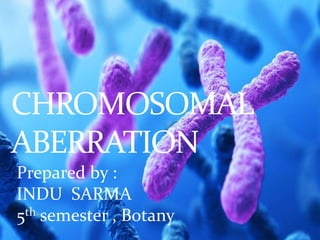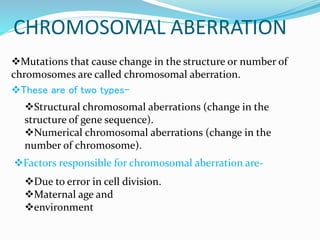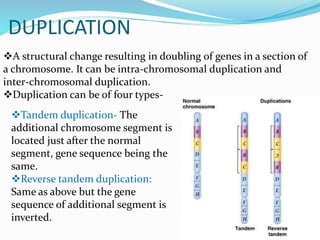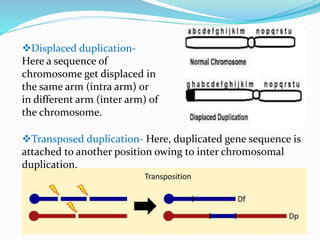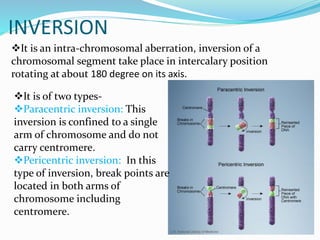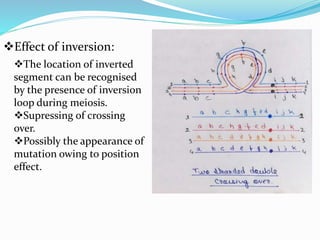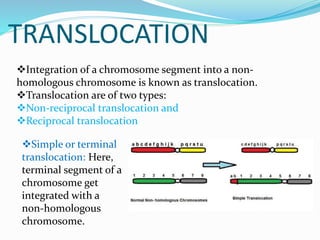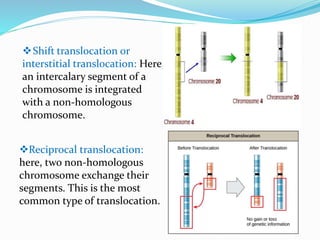Structural chromosomal aberration
- 1. CHROMOSOMAL ABERRATION Prepared by : INDU SARMA 5th semester , Botany
- 2. CHROMOSOME Chromosomes are rod shaped or thread like condensed chromatin fibres which store and transmit coded hereditary information. The structure of chromosome consist of: Chromonema Primary constriction or centromere Secondary constriction Telomere
- 3. CHROMOSOMAL ABERRATION Mutations that cause change in the structure or number of chromosomes are called chromosomal aberration. These are of two types- Structural chromosomal aberrations (change in the structure of gene sequence). Numerical chromosomal aberrations (change in the number of chromosome). Factors responsible for chromosomal aberration are- Due to error in cell division. Maternal age and environment
- 4. STRUCTURAL CHROMOSOMAL ABERRATIONS Structural chromosomal aberration can be divided into four types- Deficiency or deletion Duplication Inversion Translocation Deletion and duplication involve alteration with certain chromosomal segment being lost or doubled. Inversion and translocation involve changes in position of chromosome segment.
- 5. DELETION OR DEFICIENCY The loss of a section of genetic material and genetic information from a chromosome structure. Deletion was the first structural aberration detected by Bridges in 1917 on X-chromosome of Drosophila. Deletion can be of two types- Terminal deletion- It involves a single break near the end of the chromosome. Intercalary deletion – It involves two break in the middle portion.
- 6. EFFECTS OF DEFICIENCY Deficiency is useful in determining exact location of the gene on the chromosome. It will show pseudo dominance effect. Deficiency loop Formation takes place during synapsis. For example, in X-Chromosome of Drosophila, few bands are missing from the tip of X-band which result in formation of notches in wing margins in female fly.
- 7. DUPLICATION A structural change resulting in doubling of genes in a section of a chromosome. It can be intra-chromosomal duplication and inter-chromosomal duplication. Duplication can be of four types- Tandem duplication- The additional chromosome segment is located just after the normal segment, gene sequence being the same. Reverse tandem duplication: Same as above but the gene sequence of additional segment is inverted.
- 8. Displaced duplication- Here a sequence of chromosome get displaced in the same arm (intra arm) or in different arm (inter arm) of the chromosome. Transposed duplication- Here, duplicated gene sequence is attached to another position owing to inter chromosomal duplication.
- 9. EFFECT OF DUPLICATION Due to supply of additional genetic material and change genetic balance, they play important role in evolution at individual and population levels. For example: The theory of bar eye mutation in Drosophila is common example of duplication.
- 10. INVERSION It is an intra-chromosomal aberration, inversion of a chromosomal segment take place in intercalary position rotating at about 180 degree on its axis. It is of two types- Paracentric inversion: This inversion is confined to a single arm of chromosome and do not carry centromere. Pericentric inversion: In this type of inversion, break points are located in both arms of chromosome including centromere.
- 11. Effect of inversion: The location of inverted segment can be recognised by the presence of inversion loop during meiosis. Supressing of crossing over. Possibly the appearance of mutation owing to position effect.
- 12. TRANSLOCATION Integration of a chromosome segment into a non- homologous chromosome is known as translocation. Translocation are of two types: Non-reciprocal translocation and Reciprocal translocation Simple or terminal translocation: Here, terminal segment of a chromosome get integrated with a non-homologous chromosome.
- 13. Shift translocation or interstitial translocation: Here, an intercalary segment of a chromosome is integrated with a non-homologous chromosome. Reciprocal translocation: here, two non-homologous chromosome exchange their segments. This is the most common type of translocation.
- 14. Effect of translocation: It brings an qualitative change in the chromosome structure. It will bring about changes in the sequence of genes in chromosomes which may eventually produce several abnormalities in body characters. This is position effect. The most harmful effect of translocation is semi-sterility it causes.

